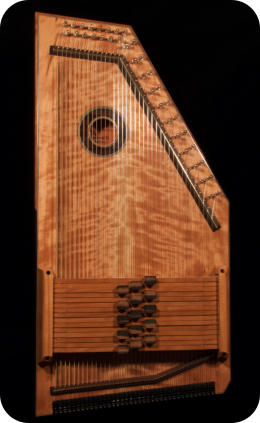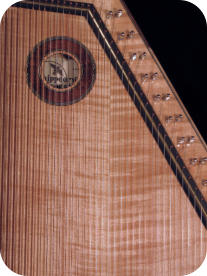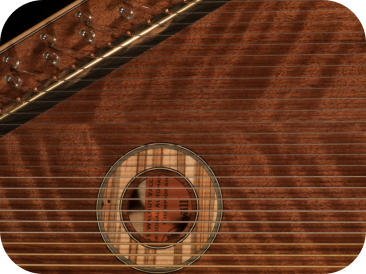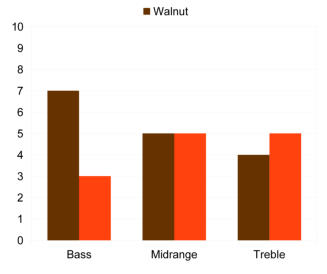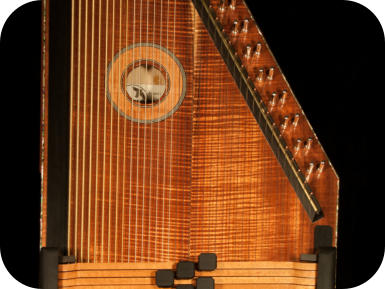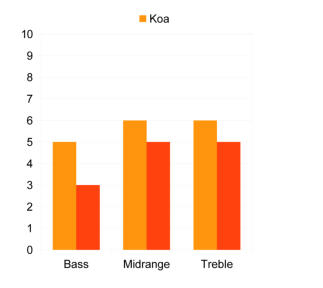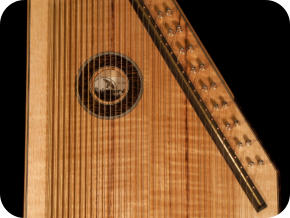
Ken Ellis
Luthier
© Whippoorwill Acoustics LLC, 2015-2023
Wood Choices and Sound
“Timber determines timbre”
-Ken
In this article we will look at the various wood choices, how they affect the sound of an instrument, and how they relate to different
styles of music and playing techniques. While most of these woods are not common autoharp woods, they are being used with
increasing frequency by guitar builders. You will find that exploring these nontraditional woods can open up new choices for your
sound.
Being able to build two acoustic instruments to have exactly the same quality and character of sound has always been problematic
for luthiers. Until now. The problem is, every piece of wood, even if from the same plank, has different acoustical properties.
Acoustical properties of wood from a given log can vary by as much as 30%.
That being said, you may be wondering if you order a custom autoharp from Whippoorwill Acoustics, will it sound like the one in the
video below? Most luthiers would have to answer “maybe”. But our proprietary acoustical testing during construction enables us to
get highly consistent sound from every instrument we build. In fact, the few opportunities which we had for building instruments
with identical sounds were quite successful. So you can be assured that a custom order from Whippoorwill Acoustics will sound very
much like the other Whippoorwill Acoustics autoharps made from the same woods.
There are no standard definitions of words for describing the sound of an instrument. The terms we use are often vague, like
“bright”, or “warm”. Not being able to relate the terminology to measurable quantities, we may each mean something different
when using the same word. This is not going to stop me from using them and it's a problem I'm not even going to try to solve here.
There are a few terms that seem to keep popping up when people discuss tonewoods: Sustain, Projection, Balance, Harmonic
Content, and Note Separation. Sadly, not all terms are used to describe all species in the references I have found. But I'm over it.
Sustain indicates how long a string will ring after being plucked. Projection is the ability to sound loud not just up close but also at
some distance from the instrument. Balance is how the bass, mid-range, and treble note loudnesses relate to each other. Note
separation is how well one can distinguish the separate notes in a chord. Do you hear a munge of sound (how's that for a musical
term?), or can you pick out the individual notes when a chord is played?
Harmonic Content deserves some additional explanation, to contrast it with Balance. While Balance can be thought of as a passive
filter, reducing loudness of some frequencies or notes relative to others, Harmonic Content is an indicator of new frequencies that
are added to the sound by the wood. A discussion of the physical mechanism behind this phenomena will be left for another time.
Harmonic Content can be described as follows. Recall that when a string vibrates, it vibrates simultaneously at many frequencies
(modes) that are approximate multiples of the fundamental (lowest) frequency. When these frequencies are exact multiples of the
fundamental, they are called harmonics. When they aren't exact multiples, they are called partials or overtones. Now vibrational
energy from the strings can be transferred to wood vibrational modes that have totally different frequencies from those of the
string modes. Thus the wood can add new overtones to the sound. Different species of wood add different amounts of overtones at
different frequencies. This is what we mean when we say that a tonewood adds Harmonic Content.
There is another effect that is in contrast with Harmonic Content. Some woods can suppress the string partials so that the
fundamental note frequency is emphasized. When this happens, the wood is said to have a “strong fundamental”.
Choosing Materials
When choosing a new autoharp, keep in mind that its sound will improve as it is played. It may take several months, a year, or more
of frequent playing for it to reach its full potential. But if you like the sound now, you will really like it after it gets “played in”. It's one
of the advantages of owning a solid-wood instrument.
Your choice of materials may be influenced by your playing style, the type of music you play, and who you play music with.
If you play lyrical solo pieces, a hardwood top with lots of sustain and harmonic content may be a good choice. If your musical style
is more up-tempo, fingers flying, you may want less sustain and better note separation. If you play both types of pieces, you might
consider having different kinds of autoharps for the different kinds of music.
If you play in an ensemble, consider the concept of musical space. Each instrument in the ensemble can be said to have its own
space that allows it to be distinguished from the other instruments even while all instruments are playing. You may get best results
from an autoharp having a balance that fills in gaps left by the other instruments in the ensemble. More clarity and less harmonic
content might also help you to find your own space in the sound of the band.
These are all suggestions to get you started. Ultimately, they are generalizations that might not apply to a particular autoharp or
situation. The final choice should always come down to what sounds best to you.
Hardwoods
So once you know how you are going to use your autoharp, you kind of have two decisions to make when selecting a wood species
for your top:
1.
Do you want more harmonic content, or less? While woods actually are spread over a range of harmonic content, we will
simplify things by dividing them into two groups: more and less.
2.
What balance across Bass, Midrange, and Treble do you want? Think of this as characterizing the wood as a three-band
equalizer. Since most people are familiar with the sound of Cherry autoharps, the balance of the woods will be described as
relative to Cherry. Cherry has midrange and treble responses that are about the same, with a little less bass. We’ll show the
Cherry response in the figures below as red bars.
Woods with more harmonic content
Wenge/Ziricote/Rosewood
These three woods add the most overtones to the sound. When tapped, most woods will just sound like you tapped a board. But
these woods will ring like a bell. They have pronounced bass and treble responses, sometimes characterized as boomy bass and
sparkling trebles. Midrange response is somewhat less than bass and treble, leaving sonic space for your voice or other
instruments.
Hickory
Not a traditional autoharp wood, but common in American forests, Hickory adds a surprising amount of overtones and is a good
substitute for increasingly rare exotic hardwoods. The bass falls between that of Cherry and Koa while the midrange and treble are
very similar to those two woods. While both Hickory and Koa add a lot of overtones, Hickory has an unusual natural reverb that Koa
does not.
Brazilian Tigerwood
Also known as Goncalo Alves, this wood adds harmonic complexity to the sound, but probably not as much as the rosewoods. It
has a balance across the octaves very much like cherry, with a clear and crisp bass, and superior midrange and trebles, but the
added harmonic complexity gives it a lush sound that surpasses that of Cherry, if you like that sort of thing.
Koa
Koa adds some harmonic complexity, although probably less than the other woods in this category. It is bright when new, but
becomes sweeter and sweeter as it gets played-in. One often sees it described as being between Rosewood and Mahogany in
sound. It has more bass response than Cherry, with about the same midrange and treble.
Woods with less harmonic content
Cherry
Cherry has a rich, projective midrange with treble to match. The bass is solid, but not as pronounced as the rest of the range. It adds
little harmonic content and, partly because of this, has good note separation.
Maple
Maple has a bright bell-like tone, due to the strong fundamental and probably the lowest harmonic content of these woods. It is
loud and projects well. Maple has a weak bass response and less midrange than cherry. Like Cherry, it has very good sustain and
note separation. When played-in, it has a very attractive chimey sound.
Oak
Oak has a clear, even sound from bass through treble. It has strong fundamentals, and a rapid note decay. Like Maple, it adds little
harmonic complexity. It has more bass than Cherry, and the midrange and treble project even better than Cherry. It makes a
wonderful tonewood, even though it is often overlooked.
Sycamore
Sycamore has a clear punchy sound that is bright like Cherry but develops more bass than Cherry as it is played in.
Sapele and Mahogany
Mahogany has a warm tone with full bass, an enhanced midrange, and soft treble. It has a strong fundamental and adds harmonic
content primarily in the midrange, giving it a fatter midrange and a nice mellow sound compared to Cherry.
Sapele looks a lot like Mahogany, but is significantly denser and so needs to be cut thinner than Mahogany. Like Mahogany, it has a
warm, enhanced midrange that produces a nice mellow sound. It has a bit stronger treble and a bit more overtones than
Mahogany, but still not a lot of added harmonic complexity.
Black Walnut
Black walnut has a sound that is described as woody and warmer than Cherry or Maple. The warm, mellow sound is probably due
to a better bass response and a treble that is somewhat muted in comparison to the other woods. Black walnut adds a little
harmonic content, which probably accounts for its “woody” sound, but still falls in the “lesser” category. It is loud and projects well.
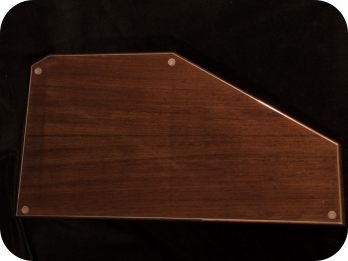
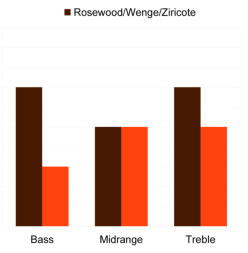
Wenge
Wenge/Ziricote/Rosewood Response
(brown) compared to that of Cherry (red)

